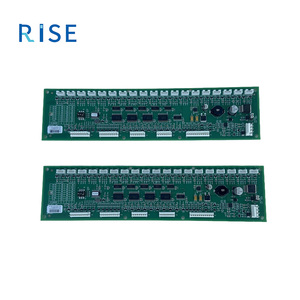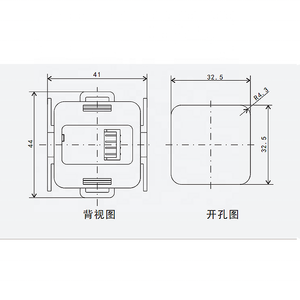(356 products available)































































































































































Elevator parts sources are divided into several categories depending on the part. They include:
Elevator Control Parts: These are the parts that are in charge of the elevator's movement, stopping, and other operations. The control panel and elevator PCB are some of the control parts.
Elevator Electrical Parts: These parts provide energy to the elevator and include lighting and signals. Electrical wiring, switches, relays, connectors, and circuit boards are some of the electrical parts.
Elevator Safety Parts: The safety parts of the elevator protect the passengers and the elevator itself. They include overspeed governors, safety gears, buffers, and door sensors.
Elevator Mechanical Parts: These are the mechanical components of the elevator, including pulleys, cables, traction machines, hydraulic cylinders, and sheaves.
Elevator Cabin and Door Parts: These parts make up the cabin and the doors. They include door tracks, rollers, cabin lighting, and control panels.
Hydraulic Elevator Parts: These parts are specific to the hydraulic elevators. They include hydraulic pumps, valves, and fluid reservoirs.
Elevator Light Parts: These parts are responsible for the lighting in the cabin of the elevator. They include LED lights, light switches, and control panels.
Elevator Signal Parts: They are used to signal the position and status of the elevator. They include floor indicators, call buttons, and emergency signals.
Elevator Wire and Cable Parts: These include the wire ropes in traction elevators and hydraulic fluid cables in hydraulic elevators. The parts transmit signals and provide power to different elevator systems.
Escalator Parts: These are parts of the escalator system and include handrails, comb plates, drive units, and step chains.
The elevator parts have different features and functions. Here is a summary of the key components, their functions, and features:
Controller
The controller is the brain of the elevator. It is responsible for the automatic operation of all parts. For instance, the buttons, doors, motor, and safety devices.
Features:
The controller has a microprocessor. It enables the execution of complex tasks like destination dispatching and learning algorithms for optimizing travel time.
Programmability: It allows customization for different types of elevators and building requirements.
Reliability: It ensures consistent operation through solid-state components and logic circuits.
Functions:
It controls the elevator motor, determining speed and direction. It processes input from the call buttons inside and outside the elevator. It monitors safety devices and ensures the elevator operates within safe parameters.
Elevator Door Parts
Elevator door parts include the hoistway door, car door, door operators, and door sensors.
Features:
Safety sensors: They prevent doors from closing on passengers. Automatic operation: Elevators have door operators that open and close the doors. Functions: They provide passenger access and ensure safe and efficient boarding and deboarding.
Cabin Parts
Cabin parts include the control panel, elevator lights, floor indicators, handrails, and elevator flooring.
Functions:
Control panel: Passengers interact with control panels to request elevator travel. Elevator lights illuminate the cabin for visibility and comfort. Floor indicators: They show the current floor and direct the elevator's travel. Handrails: Provide support and stability to passengers. Elevator flooring: It is the durable and aesthetic surface inside the cabin.
Features:
The control panel has a modern design. Elevator lights are energy-efficient LEDs. Customizable flooring enhances the cabin's aesthetics.
The elevator system is widely used in different buildings. The parts are also used in various industries. Below is a list of some common elevator applications.
Passenger Elevators:
These are the most common types of elevators. They are used to transport people from one floor to another. Passenger elevators are installed in residential buildings, commercial spaces, hospitals, schools, shopping malls, and hotels.
Freight Elevators:
Freight elevators are also known as goods lifts. They are specifically designed to carry heavy loads and goods instead of passengers. They are commonly used in warehouses, factories, retail stores, and commercial kitchens.
Construction Hoists:
Construction hoists are temporary elevators. They are used on construction sites to transport materials and workers vertically during the building process. These elevators are essential for improving the efficiency and safety of construction projects.
Service Elevators:
Service elevators are also called dumbwaiters. They are primarily used to transport goods within a building. They are commonly found in restaurants, hotels, hospitals, and multi-story residential buildings.
Auto Lifts:
Carrying passengers in an elevator is different from transporting vehicles. Auto lifts are specifically designed for transporting vehicles. They are commonly used in parking garages, car dealerships, and vehicle storage facilities.
Scenic Elevators:
Scenic elevators are installed in malls and hotels. They are designed to offer a visually pleasing experience to the passengers. These elevators usually have glass walls. As such, passengers can enjoy the views of the surroundings as they are lifted from one floor to another.
Hydraulic Elevators:
Hydraulic elevators are commonly used in low-rise buildings. They use a hydraulic system to lift and lower the elevator car. These systems are usually less complex and more economical than traditional cable-driven elevators.
Traction Elevators:
Traction elevators are widely used in high-rise buildings. They use a system of pulleys and traction cables to move the elevator car. These elevators are driven by electric motors. They can travel at higher speeds and more efficiently over longer distances than hydraulic elevators.
There are various ways to choose a reliable elevator parts supplier. One of them is checking their certifications and reviews. A reliable supplier has reviews from previous clients that prospective clients can access. The reviews give insight into what it is like working with that supplier.
Another thing to look at is the supplier's certifications. A reliable elevator supplier has the necessary certifications and provides proof of having completed the required training. The certifications also indicate that the supplier has knowledge of the industry and is qualified to provide the parts.
It is also important to check the experience of the elevator parts supplier. A supplier who has been in the industry for a long time has built relationships with manufacturers, which means they can deliver quality parts quickly and at a competitive price.
Business owners can also choose an elevator parts supplier based on the variety of products they have. A good supplier should have a wide range of products, like escalator parts and lift spare parts. Working with a supplier who has different types of products is important because it means they are knowledgeable about the industry.
To choose a good elevator parts supplier, business owners can also look at the response time. A good supplier should respond to inquiries and emails promptly. If a lift has broken down, the owner will want the repairs to be done quickly. Working with a supplier who has good communication skills and responds quickly is important.
Finally, business owners can look at the quality of the parts and the price when choosing an elevator parts supplier. It is important to find a balance between the price and quality of the parts. Some suppliers will offer their products at a lower price, but the quality may not be good. It is important to get a supplier whose product prices are within budget and offer quality parts.
Q1: What are the most important parts of an elevator?
A1: The most important parts of an elevator include the control panel, doors, and safety features. The control panel is important since it determines the destination floor. The doors provide security when the elevator is in operation. The safety features are important because they prevent the elevator from malfunctioning.
Q2: What are the parts of an elevator lift called?
A2: The parts of an elevator lift are called components. They include the control panel, doors, safety features, cable, and pulleys. The control panel, doors, and safety features mentioned above are the major components. The cables and pulleys form part of the mechanical system that facilitates the elevator's movement.
Q3: What are elevator parts and accessories?
A3: Elevator parts are the components that make up the elevator lift, as explained above. Accessories are additional components that enhance the elevator's functionality. They include mirrors, lighting, and flooring.
Q4: What are the parts of a lift machine?
A4: The parts of a lift machine include the following.
The keyword "elevator parts source" maintains a steady average monthly web search volume of 10, showing no significant change over the past year or three months. The detailed monthly data reveals a flat trend with zero web searches recorded from December 2023 through September 2024, except for a brief peak in October 2024 with 10 web searches.
This keyword's search pattern is characterized by its stability, with minimal fluctuations. The absence of web searches for most of the year indicates a low demand or limited interest in the topic. The singular spike in October could suggest seasonal variations or a temporary increase in demand, though without further context, it's challenging to infer the exact cause. The trend's consistency, or lack thereof, suggests that the market for elevator parts sourcing may be niche or specialized, attracting web searches sporadically rather than consistently.
The data reflects a highly niche market where demand does not fluctuate significantly over time. The lack of growth in web search volume over the past year and three months underscores a stable but limited interest in elevator parts sourcing. This could indicate a mature market segment where most potential buyers are already familiar with the suppliers and do not need to perform frequent online web searches.